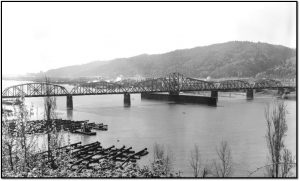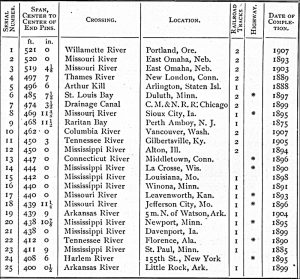Alfred P. Boller’s Thames River Swing Bridge (STRUCTURE, February 2019) remained the longest swing span in the world until J. A. L. Waddell’s Omaha Bridge over the Missouri River in 1893 with its 520-foot span. Waddell would build a bridge in 1903, very similar end-to-end to his 1893 span, with a slightly shorter span. It was not until 1908 that Ralph Modjeski built his Willamette River Swing Bridge in Portland, Oregon, with a 521-foot span and the title of the longest swing bridge was wrested from the Omaha twin swing bridges of Waddell.
The Willamette River is a tributary of the Columbia River and separates the city of Portland, Oregon. Modjeski was charged with building bridges across the Columbia River and the Willamette River connecting Portland with Vancouver, Washington, and the north. The entire bridge project was just shy of five miles long. Modjeski wrote, “To effect an entrance into Portland, the Spokane Portland & Seattle Railway Company is building two bridges, one at Vancouver, across the Columbia River, and one near St. Johns, across the Willamette River. The two bridges cross the streams very nearly at right angles and are practically on the same tangent. The peninsula between the two bridges will be crossed with a deep cut. Both bridges are double track and designed for heavy modern loading without roadways. The Vancouver bridge may be divided into three parts, as follows: The Washington channel bridge, the Shaw’s or Hayden’s island viaduct, and the Oregon Slough bridge…The Willamette River bridge is symmetrical with regard to the center of the pivot pier. The large draw span, 521 feet center-to-center of end pins, will be the largest in the world when completed. On each side of the draw span are two fixed spans approximately 269 feet center-to-center of piers, making four fixed spans in all. On each end of the bridge is an 80-foot deck plate girder approach span. The total length of this bridge is 1,762 feet 3 inches.”
Construction had started in 1890 on a single track bridge, but work stopped on the project after a swing span pier by George S. Morison in the Columbia River was placed. The Great Northern Railway and Northern Pacific Railway, fierce competitors, formed the Spokane, Portland & Seattle Railway Company to build the bridge in 1905. The bridges were also planned to serve the Oregon Railroad and Navigation Company.
Modjeski, who apprenticed under Morison, did not become involved with the project until the fall of 1905 (Morison died in 1903) when he was approached by the Spokane, Portland & Seattle Railway. He had already established a national reputation from the Thebes Bridge across the Mississippi River in 1905. He was also to become, during the construction of his bridges, one of the Engineers on the reconstruction of the Quebec Bridge across the St. Lawrence, replacing the collapsed span by Theodore Cooper and the Phoenix Bridge Company in 1907.
He generally accepted the earlier layout of the spans with minor modifications and the use of the partially completed swing span pier on the Columbia River. The Port of Portland approved the Willamette swing span in April 1906 and the War Department approved it in June 1906. The War Department specified the span length in terms of the horizontal clearance required. It is likely that Modjeski wanted his bridge to be the longest in the world, so he had his design result in the 521 feet total length of swing span. He described the design and construction of the bridges in a 1910 30-page report with plates entitled, The Vancouver-Portland Bridges, a Report to Mr. Howard Elliott, President of the Northern Pacific Railroad Company, and to Mr. John F. Stevens, President of the Spokane, Portland & Seattle Railway Company. He also published a paper on the project for the Railway Age, published on March 20, 1908.
Modjeski called his bridge “the longest, and probably the heaviest, draw span in the world.” On each side of this were two fixed spans of 269 feet each, and an 80-foot deck plate-girder approach span. While only a tad longer than the Omaha Bridge, it held the record for a swing span until the Fort Madison Bridge (1927) with its 525-foot span crossed the Mississippi River.
The draw span pier was constructed of plain mass concrete, octagonal in section, 47 feet 8 inches across, with a two-course ashlar coping. The bridge was one of the largest, mostly rim-bearing swing bridges built at a time when most engineers preferred center bearing. Modjeski stated his design called for 5/6 of the draw’s weight to bear on the rim and 1/6 on the center bearing, where some other engineers recommended equal distribution of load between the rim and center bearing.
He designed the draw span with ten 24-foot 6-inch-width panels on each side of a 31-foot center tower, going against prevailing bridge design philosophy which preferred varying panel widths. The draw span had two sloping top chord members followed by six-panel straight top chords and a five-panel hump over the center. It was designed to function as a balanced cantilever span when open and as two simple spans when closed and in a locked position.
There were two independent sources of power provided. One was two 79 HP electric motors that could swing the span ninety degrees in 1¼ minutes. The second was a gasoline engine of 165HP. It was directly connected with a generator and was intended to act as auxiliary power for the electric motors whose normal main power came from land-based sources. As an additional precaution, Modjeski designed a capstan system with which he estimated ten men could swing the draw ninety degrees in twenty minutes.
Structural work was completed in July 1908, and the span swung for the first time in October. The first train passed over the bridge on October 23, 1908. The entire bridge cost over $1,000,000 and the swing span weighed 4,600,000 pounds. It was replaced in 1989 with a 516-foot-long lift span, at a cost of $38 million, to provide greater clearance for shipping.
Merriman and Jacoby, in their A Textbook on Roofs and Bridges Part IV. Higher Structures, gave a listing of the major long span, greater than 400-foot, swing bridges built between 1875 and 1907. A. P. Boller (STRUCTURE, November 2012), one of the leading swing bridge proponents, designed bridges 4, 5, 6, 24, 25 as well as several across the Harlem River of shorter span. Ralph Modjeski built bridges 1 and 10. J. A. L. Waddell (STRUCTURE, February 2007), even though primarily a lift bridge specialist, built bridges 2, 3, 18. George S. Morison (STRUCTURE, February 2008) designed bridges 12, 16, 17.
This article is the last of the author’s series on Historic Bridges. It started with Timothy Palmer’s Newburyport Bridge across the Merrimack River and closes with Ralph Modjeski’s Willamette River Bridge in Portland, Oregon. In upcoming issues of STRUCTURE, the author will be describing the most prominent bridge failures in North America starting with the Rider Bridge failure on the New York and Erie Railroad in 1850 and ending with the Minneapolis Bridge failure in 2007. Many lessons can be learned from today’s bridge engineers by the knowledge of past failures and their causes. As George Santayana, Edmund Burke, and others have said, “those who don’t know history are doomed to repeat it.”■



